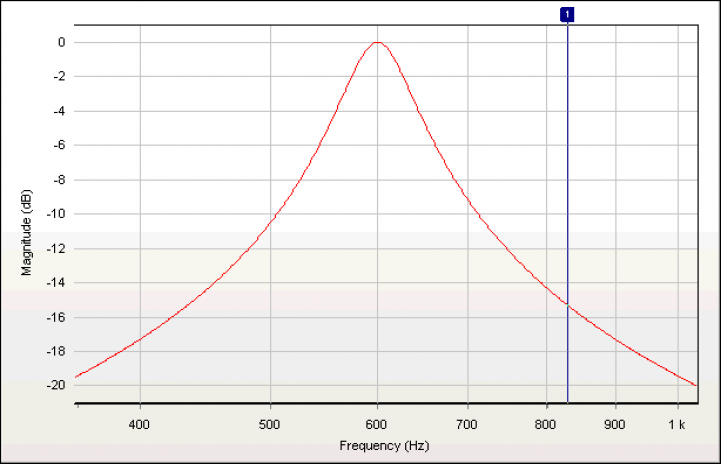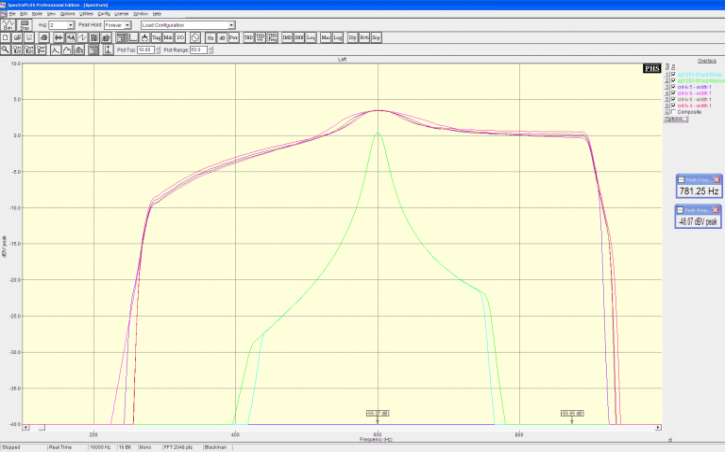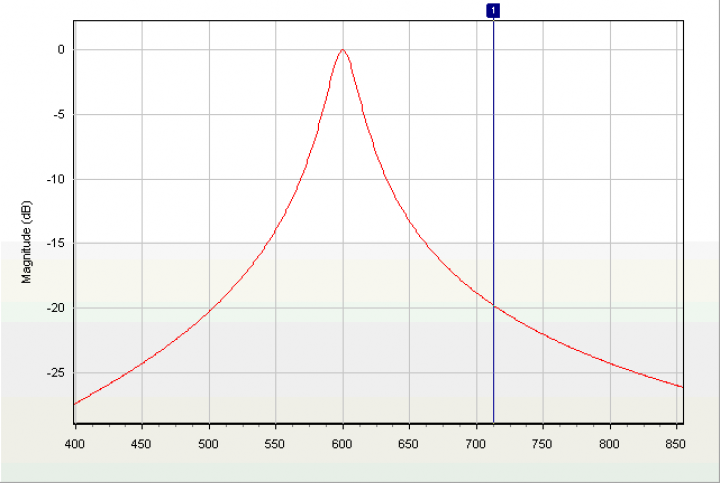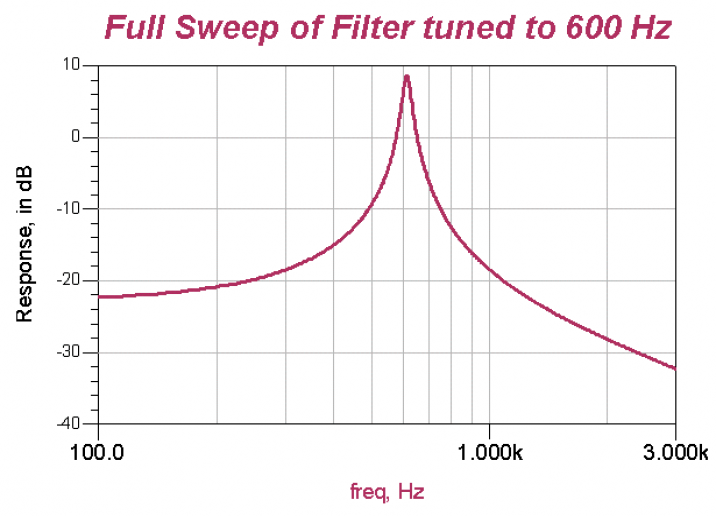Too Much of a Good Thing? One of the best features in the FT2K is the APF. Today we are taking a look at the FT5K's implementation of the APF feature to see how it compares. Engaging the APF pushes the adjacent signal strength down and has the effect of making the signal "pop out" of the noise. The Q and pole count is a delicate consideration as these two features specify in an analog design (or the digital equivalent) the filter shape. The APF is not normally intended to be a high-selectivity filter per-se, it's more appropriate description is to put a difference in the level of the signal in the center of the passband with the signals adjacent. When tuning the bands, you want to be able to hear signals coming into the filter's range, but with the APF, these signals will always be at some lower amplitude level relative to the rig's "center" or spot frequency. The APF helps the op know where the spot frequency is and aids in quick zero beating. So when you are ready for single-signal selectivity, the DSP provides that function very well and further trimming of the receiver frequency is generally not needed. The ultimate rejection (stopband) of the filter is very important. Fortunately, with a Q=2 pole count, the filter has a shallow stop band and a very peaky response. More elaborate implementations exist. For example, in the Pic-a-star project, the user can separately specify the amount of rejection beyond the center passband. That is a different and more complicated design. But one that some very serious receiver designers and ops felt this feature to be worth the complexity. The K3 last year implemented the APF similar to the way Yaesu did. For the CW op, APF is a very big feature indeed. FT-2000 APF Implementation Summary The FT2K's implementation of APF and CONT functions are described at length HERE. From that web page, we see the transmission response of the FT-2000, configured with a 200 hz filter alone ("flat top" responses) - and with the APF engaged . Often it's said that the AFP lowers the volume of the signal, but you can see from the graph that the gain of the APF is 1. When engaged, the APF pushes the noise content down giving the impression of an overall volume lowering. The same action (lowering the amplitude of signals away from the center frequency) that is responsible for the APF's "signal pops out" very favorable response. The Q=10 used in the FT2K is very nice. Enough selectivity to give the "pop" effect, but not so much that you lose the surrounding contents totally. 
The response is approximated with a 2-pole Q= 9 filter quite well as shown in the following graph. 
Engaging the APF on the 2K is mentioned later in this page. FT-5000 APF Implementation NOTE: Graphs here are taken using 0117/0532 control/EDSP software versions. The APF plot (GREEN color) is shown below. The red/pink/purple lines above that are the contour response (discussed later). Note the slope is much more aggressive than the 2K shown above. The "tilt" seen here means the filter has a log response (the way an analog filter would work) - the 2K has a more symmetrical response (amplitude response is linear with frequency). Either implementation is acceptable. 
A 2-pole Q=28 filter simulates the response almost exactly. The 2K by contrast had a Q=10, for comparison. 
Compare this curve with the similar graphic courtesy of Al W6LK based on circuit simulation of the FT-1000. I believe that the FT-1000 "Q" was closer to 20 vs. the FT-dx5000 current implementation at nearly 30. See http://sites.google.com/site/ft1000apf/FT_1000_APF.ppt for Al's original comments. 
As with the 2K, the overall gain of the filter is 1. In work with an external filter originally intended to provide APF function to the 2K's 2nd receiver, a bit more gain would be beneficial and greatly contributes to the "wow" factor when engaged. A gain of +6db is about ideal. The APF in Use This is a case of Too Much of a Good Thing. While Q=10 was good in the 2K implementation, Q=28 is far too much! Due to the much higher Q, the APF is not suitable in the "tune around the band" application. And because the skirts are so steep, you must be very closely tuned prior to engaging the filter. If the APF is engaged with a weak signal and not perfectly tuned, almost no AF output is had. And because the Q is so high, the "ringing" character of the filter is very noticeable - especially with noisy band conditions. I found 40M on the CQ WPX CW contest to be very unfriendly with the 5K's APF engaged. Yet the 2K sitting next to it and fed with the same antenna and sharing the same DSP width, produced excellent copy with the 2K's APF engaged. My point here is that the APF as implemented in the FT-2000 is beneficial for CW use in almost all of the ops time. Where the extreme Q of the FT5K makes it a specialty tool; useful only in rare instances. Wish List - APF CharacteristicsFilter "Q" - For the reasons specified above, the Q of the filter is very much too high. Something in the Q=10-15 range would be much better if only a single value were possible. Of course, a variable width would be ideal; with perhaps a choice of Q=10, Q=20 and Q=30 in the case menu-specified presets were required.
In fact, the current APF "variable" parameter is center frequency - it's not a useful function in that CW ops soon learn how to tune by ear to SPOT frequency. Which means the APF frequency adjustment is going to be unused - and when it is used, it's function is somewhat duplicated by the RIT-clarifier function. A better use of this function would be variable bandwidth (or Q). This would give the CW op full control over the APF filter characteristics. Of course, in this case, the APF center frequency would be slaved to the SPOT frequency.
Filter Gain - A gain of +6db to +9db really adds to the user enjoyment when the filter is engaged. ///////////////////////////////////////////////////////////////////////////////////////////////////////////////////////////////////////////////////////////////////////////////////// Old School APF via ContourSee this page for more details on how the rig's contour features in combination with other settings can roughly approximate the 2K/9K style of Q=10 APF. ///////////////////////////////////////////////////////////////////////////////////////////////////////////////////////////////////////////////////////////////////////////////////// User Mechanics - APF On and OffIf you are like me, as you work the bands you are constantly adjusting the DSP bandwidth and turning the APF on/off... So comparing the operation of the APF is worth consideration. Comparing the 2K and the 5K operation... 2K operation, from an OFF condition: Press and hold to engage APF. Press once to disengage. Press to engage CONT. Press once to disengage. 5K operation, from an OFF condition: Press to engage APF. Press again to disengage APF, an engage CONT Press again to disengage CONT The disadvantage of the current 5K implementation is that we are forced to step through the sequence OFF-->APF-->CONT. Other than an extra button push, why is that a problem? If the CONT LV is set very high (above 8), the volume increase from APF engaged to CONT engaged will push the speaker into clipping as the volume jump is huge. There is no way to skip the CONT step. Wish List - OperationFor optimal CW convenience, adjust the function according to mode like this: For CW operation: Press button to engage APF. Press again to disengage Press and hold to engage CONT. Press again to disengage For all other modes: Press button to engage CONT. Press again to disengage [APF mode is not applicable] Of course, if we could select the operation from a menu preset, that would make everyone happy! A Historical Note - Two Flavors of APF I discovered after writing this review initially that the FT-1000 series implemented the APF function in the similar fashion as the current FT-dx5000 does. That is, high Q. So in a sense, there have been two flavors of APF over the last 20 years. And of course, there is plenty of debate as to which is better. The Q=10 (FT-2000 style) or the Q=20-28 range (FT-1000/FT-dx5000 style). Icom and Elecraft have varying implementations of the APF as well. The IC7700, for example, is versatile with 3 different APF width options providing user-selectable customization to personal operating preference. Nice! I want to thank Jean PA0SIM and Al W6LX for their prior work on the FT-1000 APF analysis. Conclusions and Comments The 5K is a great rig. But the firmware choices specific to the CONT and APF lack refinement. The 2K's implementation was arguably better in a few ways in that the feature was useful for full time operation where the new version is rarely useful. To bring the 5K's APF up to the level of the rest of the rig's capability, just a couple of firmware adjustments are suggested by the data and operation style of the CW op. The details of the mods are listed above in red, and summarized here: 1. Lower the effective Q to something in the range of 10-15. This improves the usability of the filter in general band use, complements the DSP filtering and eliminates the current hyper-critical tuning requirement.
Changing the current APF center frequency into a APF bandwidth or Q function would be a great choice! 2. Add +6db of gain to the APF. This adds to the "pop" effect of pulling the weak signals out and would keep the AF levels below clipping level.
3. Change the button operation - so that the CONT function is not in the APF on/off loop for CW. This speeds operation and reduces operator fatigue. |